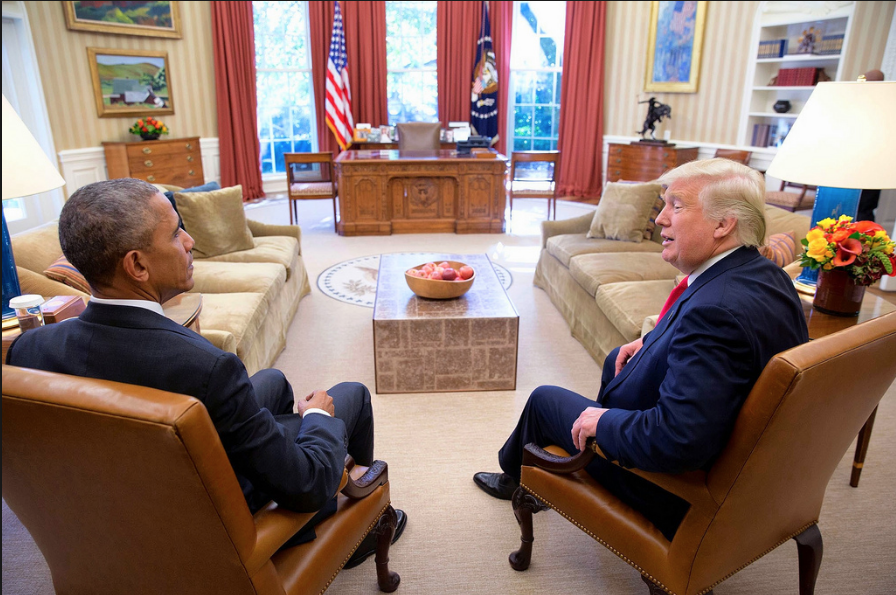Government shutdowns, distinctly american
Courtesy of Flickr
(left) President Obama resided over a 16-day government shutdown in 2013. The shutdown was led by Senator Ted Cruz (R-TX), over the healthcare debate, which eventually resulted in the Affordable Care Act. (right) President Trump has resided over two government shutdowns so far in 2018. Both shutdown efforts were led by Senate Minority Leader Chuck Schumer (D-NY) over the immigration debate, causing over three days of government shutdown.
February 16, 2018
Since 1976, the United States government has shut down nine times. In that same time period, the Australian government has never shut down, only closing its doors once in 1975. Canada has never had a government shutdown since its creation in 1867, and the United Kingdom’s government has never had a recorded shutdown due to a budget deficiency since the early creation of its parliament in 1215. Government shutdowns don’t happen around the world, but why do they happen in the U.S., and why so often?
A government shutdown is when the United States government is left without a budget and is forced to furlough its non-essential workers. The idea of the government shutdown originated in 1980 after Attorney General Benjamin Civiletti, appointed by President Jimmy Carter, issued a legal opinion that the government cannot conduct business without a budget. Since that opinion was issued, nine of the government’s 19 budget deficiencies have resulted in shutdowns.
The presidency of Donald Trump has already seen two government shutdowns in its short life, both in 2018. President Barack Obama also presided over a government shutdown in 2013, which lasted for 16 days. Though there is a striking similarity between the 2013 and 2018 and that is the party in power. During all three shutdowns, the Republican party was in control of both the House and Senate, and now the presidency as well. 2018 marked the first time in American history that a single-party government has forced a government shutdown.
Extreme partisanship, never before seen in this country’s 242-year history, has caused a streak of government shutdowns and last-minute negotiations. This is due to many politicians’ adamant refusal to compromise on policy issues, ranging from healthcare policy, the cause of 2013’s shutdown, to immigration policy, which was the center of both 2018 shutdowns.
Since early October 2017, Congress has passed three extensions on the previous budget. Each time a deadline approached, congressmen agreed to extend the current budget at the eleventh hour. The extensions allowed more negotiation and debate without shutting down the government. Democrats used a shutdown in January as a way to “put their foot down” and force real negotiation for a budget, which was only passed and signed by the president on Feb. 10.
Government shutdowns only happen in the U.S., and that’s a problem. The idea of the government shutdown goes against our government’s civic duty to the citizens of its nation. Why should thousands of federal workers, from the CDC to the National Parks Service not be able to work or support themselves and their families, just because 535 men and women in Congress choose not to compromise?
The U.S. should implement anti-government shutdown legislature like that present in Canada. The Canadian government when faced with not having a budget, simply continues fully functioning with the assumption that a budget will eventually be negotiated. This system allows Canadian citizens to take full advantage of their government’s services while it is shutdown, unlike the U.S.
American citizens should be able to take advantage of every aspect of the government that they pay for with their taxes, and it should not be taken hostage by Congress, or the President.




![Freshman choir students practice in class. “[The class] is almost like an army working together,” Anthony Nims, choir director, said.](https://whhscbox.com/wp-content/uploads/2025/10/freshman-choir.png)
![New theater teacher Mr. Mitchell leads his Stagecraft students through hands-on set-building techniques. “For me, [teaching] comes from the joy of learning, which is why I wanted to be in an educational setting.”](https://whhscbox.com/wp-content/uploads/2025/10/IMG_3248-901x1200.jpeg)

